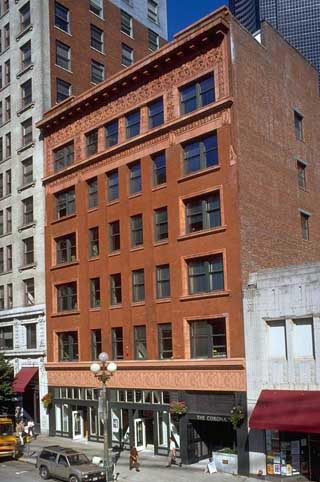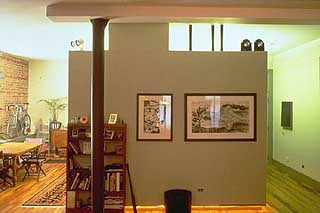|
Subscribe / Renew |
|
|
Contact Us |
|
| ► Subscribe to our Free Weekly Newsletter | |
| home | Welcome, sign in or click here to subscribe. | login |
Construction
| |
 |
October 12, 2000
Renovations bring boom times back to Pioneer Square
Coughlin Porter Lundeen
Four years ago when Samis was contemplating the future of its odd collection of buildings dotted around Pioneer Square it was only too easy to look at their shabby facades and focus on bricks and mortar issues. But William Justen, who manages the Samis portfolio, had a broader vision. Giving direction to his development team, Justen placed before them an old sepia photograph taken of the streetscape in front of the Smith Tower in the 1920s.

|
"This used to be the center of town," he said quietly, "We have to bring back the people."
The photo he referred to depicted a bustling city scene. Horse-drawn carriages and handcarts filled the streets and the sidewalks thrummed with activity. Looking out the window of Smith Tower, 90 percent occupied by King County offices, Justen’s coworkers peered contemplatively down at a handful of nervous tourists and a few office workers scurrying past with eyes downcast. And so it began.
Beyond some desultory first floor retail activity, many of the buildings in the Samis portfolio had stood empty since they were acquired in the 1940s, when Pioneer Square was a neighborhood of rundown buildings, flophouses and rough taverns.
But the high-tech boom was in full swing, fueling demand for office space with character. The Central Business District with its high towers and button-down shirts did not offer the eclectic, creative environment young companies craved. Samis set out to create office and living space to fill the gap in the market place, and to bring back the people.
As a layperson looking at the renovated buildings from the outside, the thing you first notice is that the brickwork has had a good scrub. However, the true genius of renovation happens on the inside where the building is restored with something approaching surgical skill.
While sophisticated diagnostic techniques prepare a surgeon for what to expect, architects and engineers must brace themselves for a series of surprises, often unpleasant.
"You don’t know what you’re going to find," explains Jerry Stickney of Stickney Murphy Romine Architects for whom the Terry/Denny Building revealed serious dry rot, lead paint, hidden asbestos and a very rickety exterior stairway.
But it’s not all bad news. Because the buildings stood empty for so long they evaded the destruction wrought prior to the early 1970s when preservation laws came into force to protect Seattle’s heritage. This means that in many cases beautiful old millwork is still in place.

|
While working on the Collins Building at Second and Yesler, structural engineer Eric Dann of Coughlin Porter Lundeen was delighted to find intact 30-foot floor joists with a 4-by-16 cross section.
"The wood was as straight as an arrow and absolutely knot-free," he marvels, "They were probably chopped down at the top of the hill and milled right here at Yesler’s mill. You can’t fabricate anything that good anymore."
For architect and engineer alike, the greatest challenge is to integrate the required structural and seismic upgrades in a way that is sensitive to the building's age and beauty.
Most of the buildings in the Samis portfolio are unreinforced masonry structures. The highest priority is to tie the floors into the walls and fit a lateral system where none exists. Since lateral systems cannot be fitted into existing masonry walls, the only option is to put the columns behind the storefronts. Brace frames, easier to install and less costly, are not an option. Their diagonally crossing supports are aesthetically disruptive and their bolted joints make them too rigid. In a seismic event the brace frame would hold steady while the rest of the building wagged behind it like the tail on a dog.
The solution is to install a moment frame, a large rectangular structure that is welded, not bolted. The moment frame is flexible and "goes along for the ride" in the event of an earthquake, behaving in unison with the rest of the building.
From an architectural standpoint, one of the most satisfying elements of the design is finding ways to accommodate structural, mechanical and electrical upgrades.
"For the Corona Lofts we were able to integrate the beauty of exposed brick walls into our design, and conceal cables and electrical conduits in boxed out bases," says Mike Romine of Stickney Murphy Romine Architects.
Concealing the accoutrements of millennial electrical and mechanical systems is particularly challenging given the limited space available in these old buildings. "We have to hide stuff wherever we can," laughs Chris Whitmyre of Holaday-Parks, Inc. The chiller plant and electrical vault for the Smith Tower are secreted in the basement of the adjacent Florence Building and also serve the neighboring Collins Building. Elsewhere, cooling towers are perched on roofs, hidden from sight, and VAV boxes are concealed behind cloud ceilings. In some areas an imaginative choice of finishes turns visible ductwork into an architectural feature.
The rehabilitation of each building is closely monitored by the Pioneer Square Historic Preservation Board which helps identify historic features and must approve all exterior changes and expansions. Each building has its own unique characteristics that have been brought back to life, such as the original staircase in the Corona, and the exposed elevator in the Collins, now glassed in to meet building code standards, but nonetheless restored to its former glory.
In some cases the architects were required to don their deerstalkers and undertake a little light architectural investigation. Wolf Saar of Mithun, architects for the Smith Tower and Florence Building, recounts the interesting "Case of the Old Cigar Shop."
"We had a hard time convincing the respective historical boards that the old cigar shop in the base of the Smith Tower wasn’t original. It certainly looked it, but the plans didn’t show it. We had to find photographic proof before we were able to design the current storefront that brings the retail right out to the street as it was shown in the original 1914 plans."
However, at the heart of all decisions is the driving concern for marketability. Beauty alone will not bring back the people. The Terry/Denny Building, now home to 40 high-ceilinged lofts, also sports an additional floor that accommodates eight penthouse units with breathtaking views.
Stickney smiles wryly as he remembers getting the design through the approval process. "The code required a heavy, fire-proof construction of steel and concrete and we wanted something structurally lighter and more compatible with the original building. But it worked. The penthouses have fabulous views and great appeal."
The spacious, airy lofts in the Corona and Terry/Denny have the appeal of a blank canvas to the creative professionals moving in. The Corona apartments were snapped up in a matter of months and as of last week the Terry/Denny was 80 percent leased so the hard work seems to be paying off.
The revitalized office buildings with their sophisticated modern technology are attracting an eclectic mix of tenants. Within the walls of the Smith Tower, GO.com and the Sisters of Providence find themselves neighbors, and the Collins Building office floors are 100 percent leased to the Seattle law firm Cairncross & Hempelmann.
A further issue for marketability is parking, or more accurately, the lack of it. To solve the problem, Samis identified the Butler Building. Formerly a five-story hotel, the Butler had its top three floors torn off in the 1920s to put an end to the "illegal activities" they were believed to be harboring. In exchange for the promise that the lower granite façade would be preserved, the Pioneer Square Historic Preservation Board agreed to the addition of 10 parking levels to create parking for 465 cars.
The final piece of the puzzle is street-level retail. Samis is attempting to attract tenants unique to the region and trying to steer clear of national chains. With the aim of creating a dynamic street scene, Samis hopes to entice the types of local restaurants and retailers that will coax the new mix of creative, professional workers and residents out of their buildings.
The renovation magic is working. Walk the streets of Pioneer Square today and you’ll rub shoulders with residents walking their dogs, jeans-clad professionals brainstorming the next technological revolution and art collectors browsing the galleries. Come back next spring and you may even find somewhere to park your car!
Jill Jago is marketing director at Seattle-based Coughlin Porter Lundeen, civil and structural engineers for the Smith Tower, Terry/Denny, Corona, Collins, Washington Shoe and Florence buildings.
Other Stories:
- Not imitating can be sincere flattery, too
- New research can help building owners who are shaken up by quake hazards
- Building moves to head of its class


